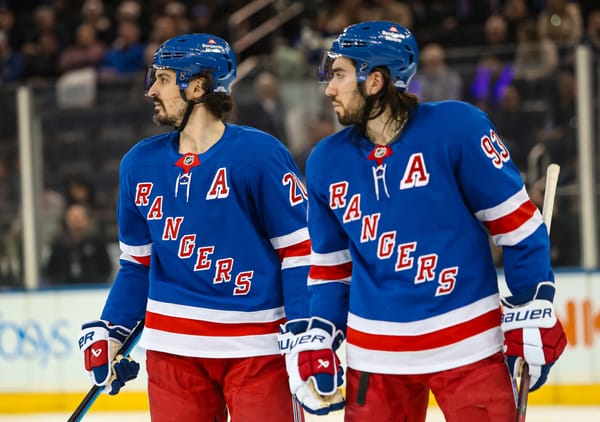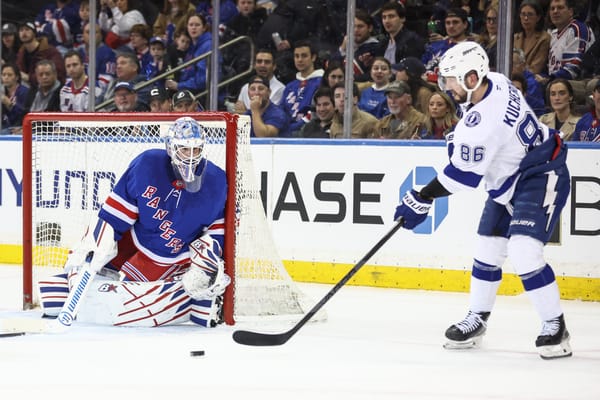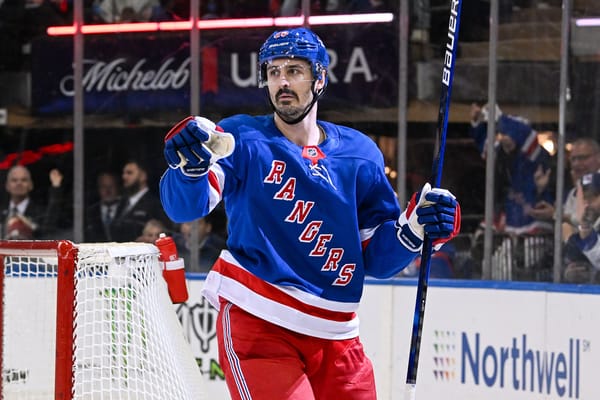Examining the Importance of the Backup Goalie Position
Team depth wins Stanley Cups, especially in between the pipes.
On January 31st, 2015, the raucous fans inside Madison Square Garden shared a collective gasp. The air had been stolen from the arena in an instant and was converted into rapid murmurs of disbelief and expletives from 18,000 mouths. It was haunting to hear, and I know it because I was there. Henrik Lundqvist was sprawled on the ice, clearly in distress following what appeared to be a routine shot on net from Carolina Hurricane forward Brad Malone. Although he would stay in the game, Rangers fans would soon learn of the major loss the team incurred despite a 4-1 win on the scoreboard that January night.
We all know, and will not soon forget, the remarkable story which developed following that fateful incident. Henrik Lundqvist was sidelined until March 27th due to a strained blood vessel in his neck. Cam Talbot would start in his stead, and in that role he and the Rangers played their way to a 17-4-3 record which vaulted them from eighth place in the NHL on February 3rd to first place on March 27th. Not only did Talbot's performance endear himself to fans and lead the Rangers to a playoff spot, it also earned him the attention of the league as a trade target. Goalies are always coveted during the offseason, but the 2015 offseason may stand out as the Summer of the Backup Goalie. Talbot, along with fellow netminders including Martin Jones, Eddie Lack, Antti Niemi and Robin Lehner among others found new teams via trade and free agency. The aforementioned goalies would be competing for a starting position on their new teams, but others such as Jhonas Enroth and Michal Neuvirth were added to provide solid depth in the crease. The Rangers joined the latter group when they acquired Antti Raanta from the Chicago Blackhawks in exchange for forward Ryan Haggerty. Let us examine the significance of this acquisition for the New York Rangers by taking a look at Henrik Lundqvist's performance and the role of the backup goalie in the modern NHL.
All Ranger fans should by now be aware of two things regarding the goalie position of their beloved Blueshirts:
1. Henrik Lundqvist is one of the two best goalies in the world.
2. Henrik Lundqvist is 33 years old, and will be 34 by the end of the season.
The Swede between the pipes has consistently been one of the best to grace the blue paint since entering the league a decade ago. However, his time and the Rangers window of prime competitiveness is rapidly dwindling. We have seen capable Rangers teams over the past few seasons fall just short of winning the Stanley Cup, and the reality of the salary cap and the inexorable advance of time is making the likelihood of seeing hockey's holy grail being paraded through the Canyon of Heroes diminish.
For the majority of Henrik Lundqvist's career, he has been relied upon to almost single-handedly lead the New York Rangers to the Stanley Cup. When scoring faltered and the defense lapsed, the King stood firm and led his team to victory. However, the minutes demanded of him and the expectations set for him have been close to unsustainably high as he enters the latter stages of his career.

Henrik Lundqvist's Career Regular Season Games Played.
The 2011-2012 NHL season saw Lundqvist play in less than 80% of the Ranger's regular season games for the first time since his rookie year. Martin Biron posted a 12-6-2 record in 21 appearances backing up Lundqvist that season. The Rangers would go on to reach the Eastern Conference Finals that year for the first time since 1997, eventually falling to a surprising New Jersey Devils team who got hot at exactly the right time of year. Although it did not end with a championship, the ability for the team to rely on Martin Biron to account for over 20 games and 26 points in the standings during the regular season benefited the team when the playoffs began.
Last year, we were confronted with the reality that the season may have been lost on January 31st because of a single shot from a fringe player on a bottom-five team. Instead, a backup goalie rose to prominence to secure another playoff appearance for the Rangers. The injury Lundqvist sustained may have been a blessing in disguise. Once again he was fresh and rested heading into the playoffs, and it showed. Through the first 12 playoff games across series against the Penguins and the Capitals, Lundqvist allowed more than two goals just twice. The dream came to an end in a roller coaster seven game series against a red-hot Lightning team where one or two bounces could have sent the Rangers to their second consecutive finals appearance. None of it would have been possible if not for Cam Talbot stepping in and assuming the role of the modern backup goaltender.
Not many teams are afforded the luxury of having two goalies on their roster who can win games on a consistent enough basis to secure a playoff spot. In fact, the few teams who have been able to win games when starting secondary and tertiary goalies during the regular season reap the rewards of having a starter with less mental and physical fatigue during their playoff run.

Stanley Cup Winners Usually Do Not Run Their Goalies Ragged.
The chart above shows the previous six Stanley Cup Champions and the number of games their goalies played during the regular season. With the exception of the historic run by Jonathan Quick and the Los Angeles Kings in 2012, teams who won the Stanley Cup played their starting goaltender in fewer than 70% of their games during the 82-game regular season campaign. Compare this to the five consecutive seasons in which Lundqvist started over 80% of regular season games, including 2010 when he also played during the Olympics, and you can see how vital it is to have a viable backup play as many games and get as many wins as possible.
The Rangers are a prime example of a team who should utilize their backup goaltender during the regular season. By acquiring Antti Raanta, it seems that the Rangers front office and Alain Vigneault understand the importance of this following the stellar performance of Cam Talbot. Raanta has proven to be a worthy backup goaltender in Chicago, posting a record of 7-4-3 alongside a .936 SV% and 1.89 GAA in 14 games played for the Blackhawks last season. In his debut with the New York Rangers this season, we saw Raanta get a shutout against the San Jose Sharks. While it is unfathomable to expect that sort of performance every night he skates onto the ice, it is reassuring to know he is capable of playing at such a high level, especially in the event of an injury like we saw last year. With Henrik Lundqvist nearing 34 years old, the Rangers would be wise to utilize their solid backup goaltender as much as possible this season. Few things provide the New York Rangers with a better chance at winning their first Stanley Cup in over 20 years than a rested Henrik Lundqvist between the pipes when we turn our calendars to June.
*Note: Thanks to Nick Mercadante for notes on chart color. Revised and re-uploaded.




